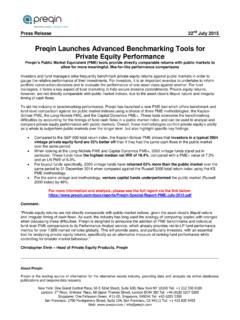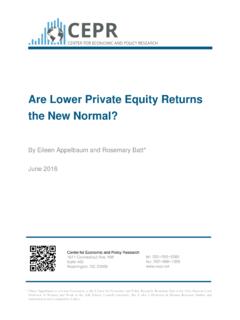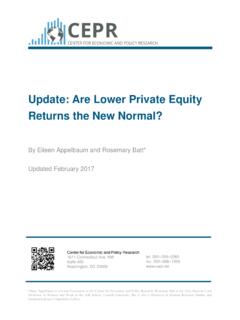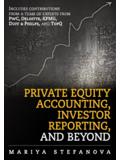Transcription of PME Benchmarking Methods - PitchBook
1 PME Benchmarking MethodsSamuel Henly August 12, 2013 Executive SummaryPME metrics benchmark the performance of a fund (or group of funds) against an indexed alternativeinvestment. For example, one could use a PME to compare the performance of a PE fund to the performanceof publicly-traded stocks indexed by the Russell 3000 Index. When PMEs are generated for many funds,the PME values can be used to rank fund performance controlling for broader market brief accompanies the PitchBook 3Q 2013 Global PE & VC Benchmarking and Fund PerformanceReport, where the company is debuting aggregate PE and VC performance indices utilizing PME Methods . Academic in Residence, PitchBook Data, two most common measures of PE performance , IRR and cash multiples, are adequatemeasurements of fund performance when used , IRR and cash multiples can t be directlycompared to indices that are used to evaluated performance in mainstream asset classes.
2 The purpose ofpublic-market equivalent benchmarks (PMEs) is to make fund performance directly comparable to theperformance of indexed asset this brief, I introduce three measures that can be used to compare the performance of privateequity to public benchmarks compare the performance of a fund, or a group of funds, with an indexed alternativeinvestment. That is, PMEs compare the performance of funds with an entirely separateclass of assets,rather than directly with a group of peer funds. Industry participants might find PME benchmarks useful incomparing a private equity fund s performance to similar publicly-traded equities; for example, a PME couldbe used to compare a healthcare-oriented PE fund to publicly-traded healthcare stocks. Going further, PMEswould allow individuals with sufficient data to compare the market-adjusted returns attained by individualfunds, generating fund performance first two PME variants I will discuss rely on the creation of a fictional PME vehicle using the cashflows of a real PE fund.
3 Once this vehicle, representing an index, is created, its IRR can be computedfor apples-to-apples comparisons with the PE fund. Unfortunately, PE funds that significantly outperformthe PME vehicle will produce nonsensical output under the first method. The second method avoids thisproblem, at some cost of last PME variant avoids the creation of an intermediate vehicle, and instead generates a cashmultiple that discounts PE fund cash flows by indexed market PME: A Public Market EquivalentDefinition and proposed in 1996,3the Long-Nickels PME (hence, simply PME )benchmark answers the question: if an investor had made contributions to an indexed fund instead of aPE fund, and if these contributions (and the resulting distributions) were the same size and made at thesame time as they were for the PE fund, what would the return be?
4 In this sense it is arelativemeasureof using PME benchmarks, a PE fund is compared to a hypothetical alternative investment, thePME vehicle. The idea is to take cash flows of a PE fund, redirect them to (or from) the PME vehicle, andobtain the vehicle s NAV for use in an IRR a thorough discussion see Ellis et al (2012),Measuring private equity returns and Benchmarking against public Research their 2013 working paperPrivateEquityPerformance:WhatDoWeKn ow?, Robert Harris, Tim Jenkinson, and StevenKaplan use this PME measure to evaluate US private equity , Austin M. and Craig J. Nickels (1996),A private Investment Benchmark. Presented at AIMR Conference onVenture Capital the following set of net contributions and index values, and the resultingNAVP MEvalues calculated in each Net ContributionIndexPME Vehicle NAVPME Vehicle NAV calculation1801008080 1001002-301206680 120100 30 90100 30 90120+ 50 100100 30 100120+ 50 10090In each period when net contributions are positive that is, when an investor pays into a fund the NAVof the fictional PME vehicle is updated with a purchase of equal value of the indexed asset.
5 For example,in the first period, a contribution of $80 to the fund is mirrored by an $80 purchase into the indexed net contributions are negative when an investor receives distributions in excess of his or hercontributions an equal quantity of the indexed asset is sold. In the second period, for example, $30 of theindexed asset is sold when the investor receives a $30 , finally, that the value of each net purchase (or sale) of the indexed asset is tracked. Consider theinitial $80 purchase. In the second period, its value has increased to$80 120100= $96as the index increasesto120from100; but, in the following period, its value drops to$80 90100= 72as the value of the indexplummets. Of course, the denominator of this asset purchase will always be100, the value of the index atthe time of the purchase. Similarly, the $30 sale in the second period will always have a denominator of120, the value of the index in the period of its an explicit formula for PME NAV computation, please refer to Appendix +Shortcomings of a twist on the example in the previous section:4 Adapted from Ellis et al (2012),supranote this briefNAVhas the same meaning asremaining cnet,tItNAVP ME,tNAVP ME,tcalculation1201002020 1001002301005020 100100+ 30 1001003-4050-1520 50100+ 30 50100 4050504050-1520 50100+ 30 50100 405050 What s this?
6 In period 2, it seems that the PME vehicle has a negative NAV. Not a negative return anegativevalue! It s difficult to assign meaning to a result like this; one interpretation is that PE-matchingcash flows result in a short position in the indexed asset. Even if one accepts this curious interpretation, itdoesn t help the fact Benchmarking with a PME is impossible in this case: one can t compute an IRR foran investment with a negative NPV. (Try it in Excel, if you like you ll get an error.)The PME+ uses a computational fudge to work around this + avoid negative NPVs, Rouvinez6proposed keeping final-period NAV rather thancash flows constant between the PE fund and the PME the PME+ method, the NAV for the PME+ vehicle is computed identically to the NAV for the PMEcase, with the exception that distributions are scaled by a constant7. This constant is chosen to ensure thatfinal period NAV is equal for the PME+ vehicle and the PE fund.
7 The PME+ method does not ensure apositive PME vehicle NAV foreveryperiod, but this is the usual downside to PME+ is that it does notperfectlymatch the cash flows of the PME vehicle to thecash flows of the PE fund. However, it does match themreasonably well, an explicit formula for PME+ computation, and for an example, please refer to Appendices B andC, is a Market-Adjusted Cash a 2005 paper8, Kaplan and Schoar proposed analternative PME method that this brief will refer to as than creating a separate (fictional)investment vehicle, as the previous Methods do, the KS-PME discounts cash flows in a cash multiplecomputation by the returns to a public index since the fund s inception. The KS-PME may take the formof either a TVPI-like metric or a DPI-like metric; an explicit formula for each is presented in Appendix (2003), private equity Benchmarking with PME+.
8 Venture Capital Journal, August: constant is just a fixed number: some examples are1,14, , and So, if a $1000 distribution is made by the PE,and the scaling constant is12the PME+ vehicle distribution is $ Kaplan and Antoinette Schoar,PrivateEquityPerformance:Returns, Persistence,andCapitalFlows. Journal ofFinance 60(4): authors have subsequently referred to their method as the Market-Adjusted Multiple to distinguish it from theLong-Nickels funds should be compared with public market indices using the TVPI-like metric, while fully-realizedfunds should use the DPI-like Simple the following simple example where a fund s DPI is computed side-by-sidewith a DPI-like KS-PME:t contributiontdistributiontItDPItKS PMEDP I, consider the last-period DPI:DPI2= , indicating that the total amount paid out by the fund(50) is 67% more than was paid into the fund (30).
9 Now, compare the DPI figure with the KS-PME value in the last period:KS PMEDP I,2= 3. TheKS-PME returns a number nearly twice the value of DPI. Why the difference? The distribution in the finalperiod was made at a time when the public market was collapsing. The KS-PME is so much larger thanthe DPI because the fund managed to produce a huge distribution in a period when the alternative assethad fallen in value. Put another way:compared to the alternative asset class, the fund was doing evenbetter than it appeared to have done in a Public Market Equivalent MetricsLong-Nickels PME and PME+.Using a PME or PME+ vehicle s contributions, distributions, and NAV,one can compute the IRR for the reference security. The IRR so computed will be directly comparable tothe original fund. For example, had the PME vehicle been liquidated in period 4, its IRR would have ; if the PE fund had produced an IRR of anything greater than , its manager could claim thatit had outperformed the public are several considerations to be aware of when using PME , one must be careful when choosing an index.
10 Indices used for comparison ought to provide someinsight into a fund s performance . Comparing the performance of a VC fund to, say, the Russell 3000 Indexis not as useful as a comparison to a PME benchmark based on a small-cap index; PitchBook currentlyuses the Russell 2000 Growth Index for VC Benchmarking . Worse, if the index ignores dividend paymentsor coupons produced by alternative investments, the PE fund will seem to outperform to a greater extentthan it really , the PME is better-used to judge the performance of mature funds where remaining NAV issmall relative to contribution size; the PME has an implicit assumption that an investor is able to liquidatehis or her holdings in the last period, and this assumption is less important if the final NAV is distinction is not actually important for fully-realized funds: when NAV=0, the two variants be numerically , while cash multiples can be computed for PME vehicles, I strongly advise against it.










